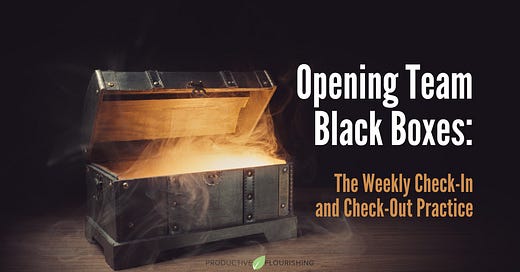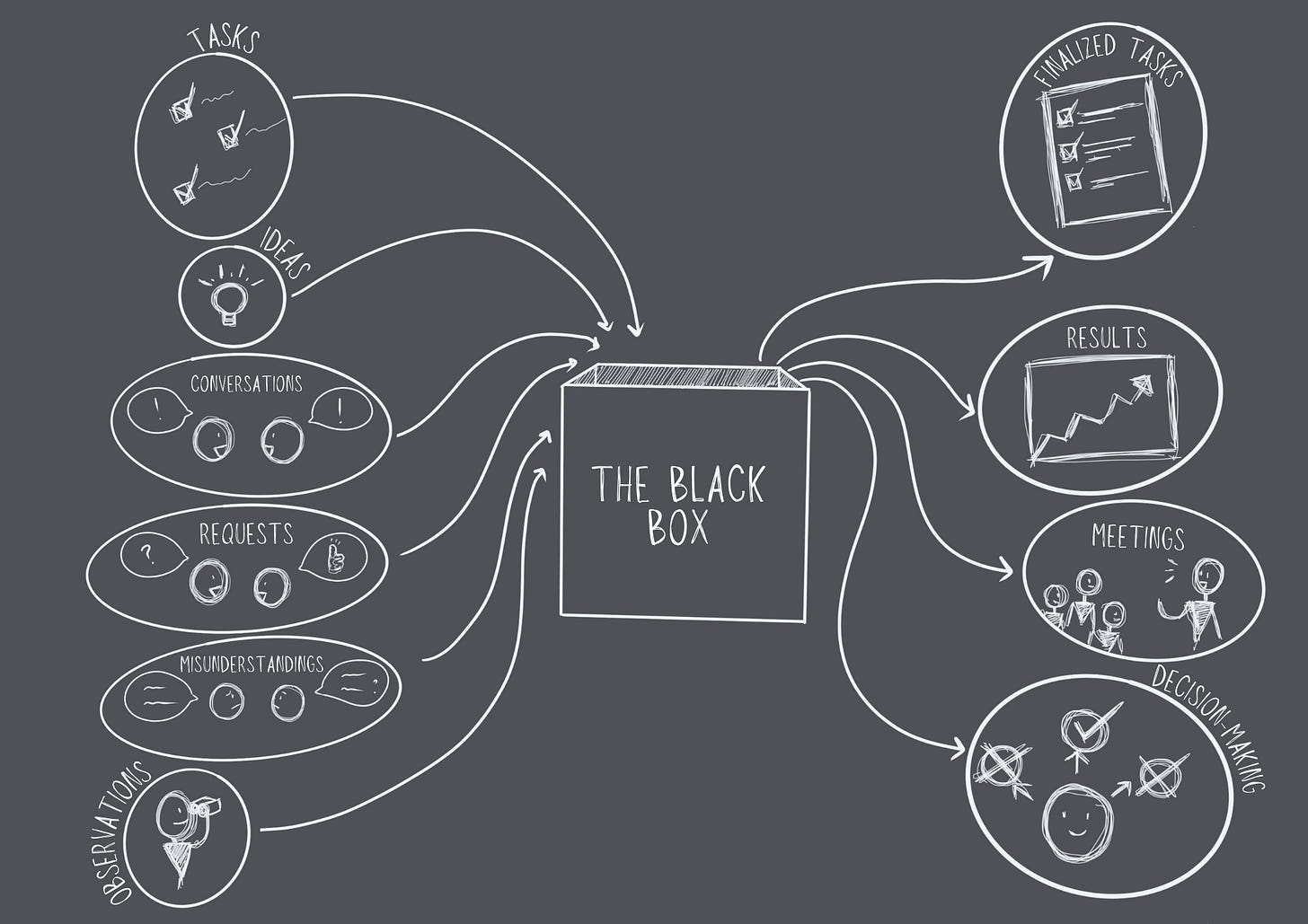Opening Team Black Boxes: The Weekly Check-In and Check-Out Practice
Just one team habit to enhance communication and build trust (with worksheet)
Ever get that feeling like you’re not quite sure if everyone on your team is really on the same page? You suspect someone might be hitting a roadblock, but you only find out about it when it’s too late to help? You wonder if work is being duplicated because people don’t know what others are working on?
In Team Habits, I talk about the problem of “black boxes” in teamwork. In computing, a black box is a system where you can see the inputs and outputs but have no idea what the internal workings are. It’s like a top-secret factory where widgets go in and bicycles come out, but you have no idea what happened inside to get from widget to bicycle.
Black boxes happen in teams all the time. You may know your teammate is doing great work because you see the final product, but you have no idea how they do it or what they’re working on at any given moment.
This lack of visibility creates several problems:
You might start initiating the same work someone else is already doing
You begin feeling anxious about whether work is happening at all
You start worrying you’ll have to jump in at the last minute to save a project
Trust erodes when people can’t see how others contribute
Too often, our solution is to expect our teammates to be mind readers. We assume they know exactly what we need, when we need it, and how we want it done — without ever making those expectations explicit.
One Habit to Bring It All Together
Let’s face it, information tends to be shared whenever and wherever someone remembers to bring it up. In Slack threads, quick hallway chats, or those “just pinging you” emails. It’s scattered, reactive, and often overwhelming.
That’s why creating a consistent rhythm for communication is so powerful. The weekly team check-in and check-out isn’t just another meeting. It’s a focused practice that contains the noise and makes space for what matters.
Here’s what this practice can do for your team:
Reduce communication clutter. Instead of updates popping up at random, you’ve got a dedicated space to share important-but-not-urgent info.
Find your Goldilocks zone. Not too much, not too little — just the right frequency and depth of communication for your team.
Keep everyone aligned. You’ll avoid duplicated work and unclear priorities by starting the week with shared focus and ending with shared reflection.
Build trust through transparency. When people know what’s happening, and how, they’re more likely to step up and support each other.
I know the knee-jerk reaction to “another meeting” might be resistance. But hear me out: this simple practice often replaces other meetings. It cuts down on ad-hoc check-ins and repeated status updates by giving your team a dependable touchpoint — one that flexes with your evolving needs.
This isn’t a set-it-and-forget-it tool. It’s a starting point. Most teams benefit from doing this weekly for at least a quarter, enough time to build the habit and tune your dials. Once established, you can revisit the cadence and adjust: maybe biweekly or monthly works better down the line. But to get to that clarity, you need this consistency first.
A Team Version of the 10/15 Split
This team practice builds on a core concept from Start Finishing: the 10/15 Split. Just as individuals use 10 minutes at day’s start to plan and 15 minutes at day’s end to reflect, teams need their own rhythm of planning and reflection. It’s the same principle, scaled up: break the cycle of reactive work by creating intentional space for alignment and review.
The weekly check-in and check-out translates individual clarity into team clarity.
Just as the 10/15 Split helps individuals stay grounded, focused, and clear, the weekly rhythm helps teams build alignment, surface obstacles early, and reduce the constant churn of “figuring it out as we go.”
Here’s how the rhythm works:
The Weekly Check-In (Beginning of Week):
Set priorities. Clarify the three to five key projects for the week (fewer is better).
Highlight important deadlines and events. Make sure everyone is aware of what’s coming up.
Spot potential blockers. Bring obstacles into view so the team can respond before they become problems.
The Weekly Check-Out (End of Week):
Celebrate wins. Acknowledge progress and contributions to keep momentum strong.
Review stuck or stalled work. Talk through anything that didn’t move forward and why.
Capture the unexpected. Note any projects or issues that emerged during the week and didn’t make it into the original plan.
Bookending your week this way gives your team a steady rhythm for communication. Instead of relying on chance conversations or scattered updates, you have a clear, repeatable structure that supports forward motion.
It also helps cultivate something essential to high performance: teamsense. Like I said in “Make the Obvious Explicit to Improve Team Performance,” where I introduced the concept:
One of the many reasons high-performing teams perform well is that they have teamsense: their shared knowledge and practices are such that they all “see” and “know” the same things and also know what everyone’s going to do to address the opportunity or issue.
That shared awareness creates smoother handoffs, fewer surprises, and stronger follow-through. Teamsense isn’t the whole story — a team can have awareness and still get stuck — but it’s a necessary foundation for high performance.
As your team builds that shared understanding and strengthens its team habits, you may find the check-in becomes less necessary. Many R3+ teams (teams with strong rhythm, trust, and performance) eventually drop the beginning-of-week check-in altogether. Their teamsense is strong enough that a focused end-of-week check-out is all they need to stay aligned and responsive.
If you’re not a paying subscriber, you’ll need to upgrade to get access to the deeper dive sections below, and the accompanying worksheet.
Why Start with the Check-Out?
The Three Essential End-of-Week Check-Out Questions
The Three Essential Beginning-of-Week Check-In Questions
How Long Should These Meetings Take?
The Result: No More Black Boxes
Ready to Implement? Use Our Worksheet
Paid subscribers, you’ll access the rest of the content and worksheet below. Please be sure you’re logged in to your paid account.






